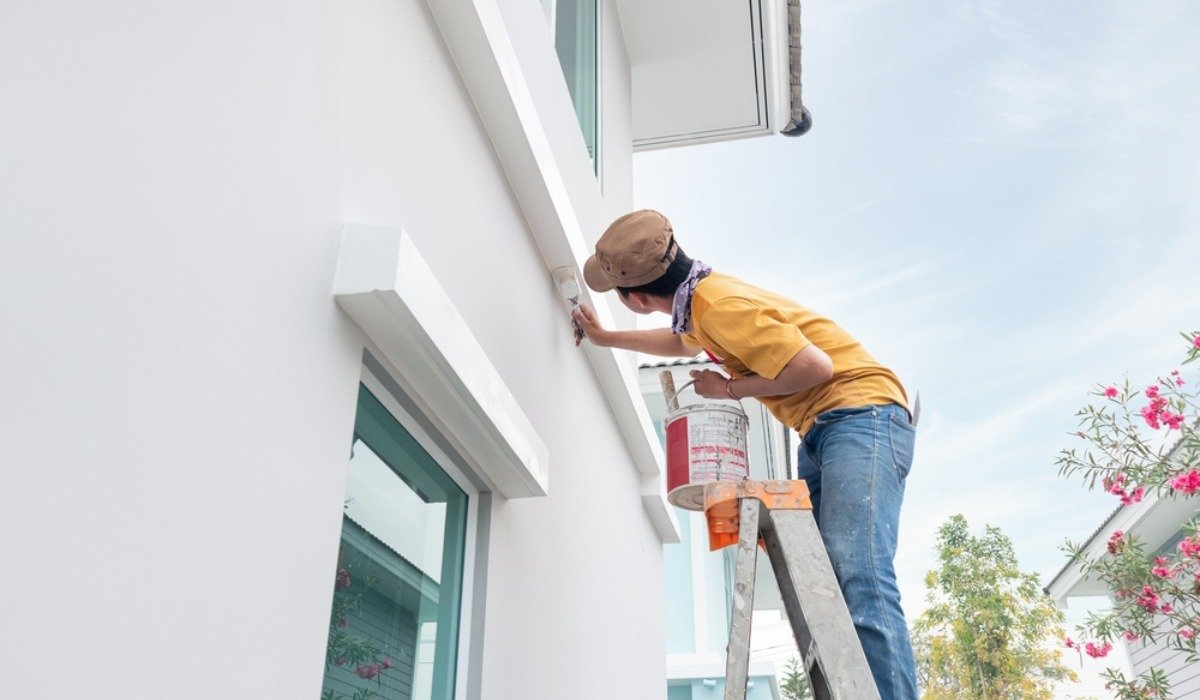A new coat of paint can enhance the appearance of your home’s exterior significantly. Painting not only improves the aesthetic appeal of the home, but it also protects it from the elements. In this article, we will guide you through the step-by-step process of painting the exterior of a house.

Source: Pinterest (the architects diary)
A step-by-step guide to help you paint a house exterior
Materials required
- Paint scraper
- Filler
- Sandpaper
- Plastic sheets or drop cloths
- Painters tape
- Primer
- Paint brushes and roller
- Paint
When choosing paint for the exterior of your home, it is critical to choose a high-quality exterior paint. Aspects like weather resistance, durability and the desired finish should be taken into account. Additionally, it is important to choose colours that complement your house and blend well with the surroundings.
See also: How to paint tiles at home?
Procedure
Precautions
- Wear protective clothing, including goggles and gloves.
- Use a sturdy ladder that is appropriate for the height you are working on. Ensure it is situated on a stable and level surface. Have someone assist you if you are working at higher levels.
- Cover the nearby area by using drop cloths or plastic sheeting.
- Store paint cans away from extreme temperatures and direct sunlight.
Prepare the surface
Make sure you choose a sunny day when the weather is mild and dry, without any rain in the forecast.
- Start by cleaning the exterior walls using a pressure washer or a hose and scrub with a mixture of detergent and water. This will remove any dirt, grime, and loose pain. Rinse the cleaning agent off, then allow the surface to air dry before moving to the next step.
- Check the current condition of your home’s exterior and take note of any repairs that need to be addressed before painting.
- Next, use a paint scraper to remove any loose or peeling paint from the walls and trim. Inspect for any cracks or holes in the surface and fill them with a suitable filler. Let the surface dry and sand it to create a smooth and even texture that will help the paint adhere better.
- Remember to protect the surrounding areas you don’t want to get paint on. Cover plants, bushes, and the ground with plastic sheets or drop clothes. Make sure to remove any outdoor furniture that may hinder your work. Use painter’s tape to mask off windows, doors, and trim.
Prime the surface
Primer improves adhesion and coverage on the surface. It also helps the paint to last longer and provides a uniform finish. Priming is required if your surface is porous or if it has already been painted with a different kind of paint.
Apply the primer evenly across the entire surface with a roller or a brush and allow it to dry completely.
Paint the surface

Source: Pinterest
Start by painting the trim, windowsills, door frames, and any other decorative elements. Work carefully to avoid drips or uneven coverage. This helps you achieve a clean and precise finish.
For the larger areas, use a paint roller to apply the paint in smooth, even strokes. Work your way from top to bottom in small sections to ensure consistency and a uniform finish. Apply pressure on your roller to spread the paint evenly. Make sure to always maintain a wet edge when painting to avoid lap marks or streaks on the surface. Paint in smooth, equal strokes, gently overlapping each one after the one before the paint dries. If there are any drips, paint them out immediately while they’re still wet.
Let each coat dry completely. To achieve a long-lasting and professional-looking finish, apply multiple coats of paint. Follow the manufacturer’s instructions regarding drying times between coats. To avoid peeling, remove the painter’s tape while the paint is still slightly wet.
Final touches
- After you have finished painting, carefully inspect the painted surfaces for any missed spots, drips, or uneven areas. Touch up these areas as needed.
- Remove the drop cloths and the sheets and clean up the area.
- Inspect your painted surfaces on a regular basis for signs of wear or damage, and touch up as needed to keep your home’s appearance and protection.
FAQs
How often should I paint my house's exterior?
Depending on the environment and the state of the current paint, it is advised that you repaint the outside of your home every 5–10 years.
What type of exterior paint should I use?
Choose a weather-resistant, high-quality exterior paint that is suitable for the surface you are painting on.
What should I use to paint the exterior: roller or brush?
For small areas, edges, and trim, use a brush, and use a roller for the large areas.
How do I protect windows, doors, and the surrounding areas from accidental paint drips?
Use painter's tape to mask the windows and doors, and use plastic sheets or drop cloths to protect the nearby area.
Is it necessary to apply a primer before painting?
Priming improves paint adhesion and provides a more uniform finish.
How long does the exterior paint take to dry?
The drying time depends on the type of paint and the weather.
How many coats should I apply?
Apply two coats of paint to ensure better coverage and durability.
How do I maintain the painted exterior?
Regularly inspect the surface. Touch up any areas and clean the surface periodically.
Should I hire professionals to paint the exterior?
It depends on your skills and the complexity of the project. Hiring professionals ensures a high-quality and durable finish.
Can I paint over the old paint?
It is not advised because the new paint may not adhere properly and may also show through.
How do I achieve a smooth finish?
For a smooth finish, use a fine-quality brush to paint the edges and the trim and use a roller for large areas.
How long should I wait to apply the next coat?
For the drying time, follow the manufacturer's instructions.
| Got any questions or point of view on our article? We would love to hear from you. Write to our Editor-in-Chief Jhumur Ghosh at jhumur.ghosh1@housing.com |
Housing News Desk is the news desk of leading online real estate portal, Housing.com. Housing News Desk focuses on a variety of topics such as real estate laws, taxes, current news, property trends, home loans, rentals, décor, green homes, home improvement, etc. The main objective of the news desk, is to cover the real estate sector from the perspective of providing information that is useful to the end-user.
Facebook: https://www.facebook.com/housing.com/
Twitter: https://twitter.com/Housing
Email: editor@housing.com












